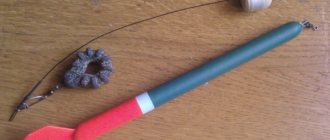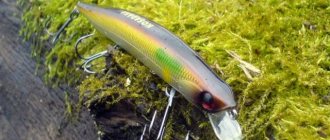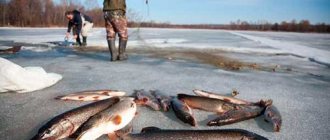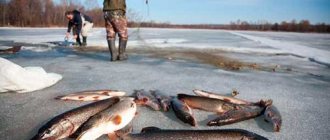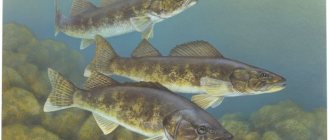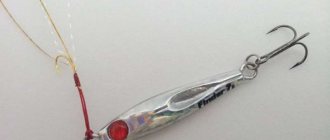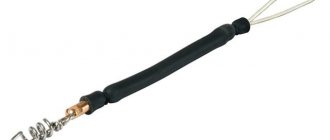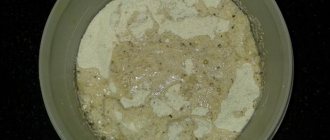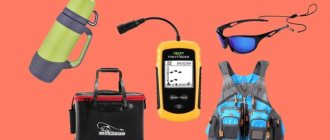Roach fishing in winter holds a special place in the heart of every winter angler. When neither bream, nor crucian carp, nor even perch are caught, the roach helps out. But this does not mean that winter fishing for roach is a simple activity. Sometimes you manage to catch a lot of this fish without preparation or trouble, but such luck is rare, and the catches usually contain fish weighing up to 120 grams. To catch this fish constantly, you need to know the subtleties and some biological features, and use as much knowledge as possible. The silvery beauty does not hibernate in winter, alternating periods of high and low feeding activity. Soroga is present in large numbers in water bodies, but is not always caught. The fisherman needs to find a feeding school or entice inactive fish to bite.
Features of winter behavior
You can catch roach in winter. You just need to understand some of the biological features of its behavior. Fishing for roach in winter is changeable, but this is not to say that this fish is unpredictable. Capricious - yes, probably. The strong weather dependence of roach in winter has long been known.
Factors influencing biting:
- Season.
- Atmospheric pressure and wind.
- Type of reservoir.
- Region (our country is large, and the habitat conditions of this fish vary accordingly). Taran, serka - on the Don, vobla on the Volga, chebak in Siberia, soroga in the northern regions - all these names belong to the same species.
- What does the sorog eat in winter in this reservoir.
The influence of weather on the bite
Roaches bite unstably in winter. And the reason for this is the weather and water conditions. Underwater currents, water temperature, movement of zooplankton masses, dissolved oxygen levels - everything affects the bite. It has been noticed that any fish bites better in constant weather, without sudden jumps and changes. It should be taken into account that in cold water fish do not need a lot of food, since calorie consumption with a slowed metabolism is small. At what pressure does a roach bite better in winter?
Influence of atmospheric pressure
The fish feels great at both high and low atmospheric pressure. The pressure itself does not directly affect her condition - this is a myth. Pressure is simply a measure of atmospheric changes. As the weather changes, the situation in the reservoir also changes, and feeding cycles shift. When the bite is bad, you should complain not about the weather, but about the wrong fishing tactics. With sudden changes, the fish simply do not have time to adapt to the new conditions. The biting at this time can either stop or resume with renewed vigor. The fish may not bite even in seemingly fine weather - simply because it has already eaten enough the day before.
So in what winter weather does roach bite best?
The best atmospheric pressure for catching roach is constantly high, average or slightly below normal. The main thing is that there are no sudden jumps. Uniform, gradual changes are acceptable. The soroga is active all winter. Therefore, in January and February, when other fish are not particularly active, fishing can be very successful, as long as weather conditions permit.
Wind influence
The wind also affects the bite. In strong and gusty winds, fish are often not caught. This is more relevant for large bodies of water. Even thick ice in strong winds on reservoir areas moves in waves, which are noticeable only by fluctuations in the water level in the hole. At such moments the bite is poor or non-existent.
For biting, you need quiet, stable weather, without surges in atmospheric pressure, sudden increases and decreases, and without strong gusty winds. Other weather factors are not so important - fish are caught both in the thaw and in twenty-degree frost, day and night.
Search and catch tactics
Ice fishing for roach is based on a search strategy. If in small rivers this fish is present almost everywhere in certain quantities, then in large reservoirs and lakes it migrates quite actively in winter in search of food and oxygenated water.
Sorozhka is a schooling fish. And it is divided into flocks according to age and size. The size of the fish that bites is the one that stands under the hole. If you start catching small fish while fishing, we move to another place or wait for the next school to arrive. To catch a large roach in winter, you need to find it. An adult sorog is not as lively as a small one, and stays in separate small flocks deeper.
Winter habitats
How to find roach on a pond in winter? In the cold season, this fish moves to deep areas, away from the shore. The optimal fishing depth is up to 5-6 meters. This fish doesn't stand any deeper. The parking location also depends on the amount of oxygen - the flock will not enter musty shallow muddy backwaters. Catching roach in winter will be successful in large areas with a slightly silted or hard bottom with numerous irregularities and changes at depths of 4-5 meters, on long exits from pits. The fish avoids strong currents, but likes to stand next to it in calm water. The main thing is that there is food, so there will be no track on bare sand either.
The largest fish of this species, weighing up to a kilogram, lives in deep holes with underwater vegetation and colonies of dreisna shells, often next to schools of bream. A mature sorog feeds on these shells, crushing the shells with its pharyngeal teeth. The number of such trophies is small, and it is advisable to hunt for them if the specific habitat is known. Therefore, the main fishing object is a medium-sized fish, weighing 200-400 grams. In winter, it gathers in large schools, and if you find an approximate square of its habitat, you can fish here all winter. In such places, fishing towns of tents are formed. True, due to the rotting of bait residues (or other factors), the fish can leave at any moment. Therefore, some fishermen prefer to search on their own, rightly hoping for larger specimens.
On small rivers
Finding roach in winter on small rivers is easier than on large reservoirs, due to the simple determination of the approximate bottom topography. And there are simply no vast areas for migration here. Holes are drilled in deep-water areas with vegetation, exits from pits, in places with reverse flow, and in sinkholes under a steep bank. Small rivers are promising places for catching roach in winter. Local fishermen, who thoroughly know their home rivers, catch roach in such treasured places all winter.
On reservoirs and lakes
Catching large roach in winter is most successful in large reservoirs or lakes. Here the fish gather in huge schools; the fisherman can count on a very decent catch if he finds these clusters. For example, catching rams in winter on the Tsimlyansk Reservoir, in a favorable situation, no longer resembles fishing, but commercial fishing. This usually happens already in March, when huge flocks, preparing for spawning, come closer to the shore and begin to feed intensively
Where to look for roach in the reservoir in winter?
In areas with a depth of up to 6 meters, with drops and shelters. Soroga loves flooded beds of streams, rivers, pits and ditches. If such an anomaly is found in a long, flat area, do not doubt that this place will gather the entire flock from nearby water areas. Good places are large patches of medium depth, rich in food, rising above the prevailing bottom topography far from the shores.
Catching roach in winter on a natural lake is no different. But if the reservoir is not shallow, then you should look close to the shore, at an acceptable depth or near the islands. Of course, this is not a complete list of places where you can catch roach in large bodies of water in winter. Due to the enormous size of our country, the variety of possible conditions is great. We have noted the main trends, but the details need to be clarified when directly preparing for fishing, using information from forums or from local experts.
On ponds and quarries
Catching this fish in winter in quarries, especially old ones in which an ecosystem has already formed, can also be successful. But here it is important to take into account some features. Firstly, in quarries it is impossible to determine the bottom topography by external signs; under a steep bank there may be a shoal, and under a flat bank there may be a deep hole. Such reservoirs were formed artificially. Here an echo sounder or depth gauge will come to the aid of the fisherman. Winter gear for roaches in the still water of a quarry needs to be as light and inconspicuous as possible - after all, the water here is usually clean, especially if the bottom is rocky.
Catching roach in winter is also possible in a pond, the main thing is that it is found there. Fishing can be successful even in a very small pond, the main thing is to choose the right keys. Pond conditions vary. The general pattern is that the largest roach will always occupy the best places for it, simply because there are not as many of them in the pond as in reservoirs. And if you find such a place, you can count on a significant catch.
Ice fishing for roach and bream at night
To night ice fishing for roach
, was successful, you need to find the right place.
At night in winter, catching roach from the ice is somewhat easier than bream. If, for example, in the daytime roach is caught well in some area, then in the dark it will be caught no worse. But in such cases it is recommended to move slightly towards shallow water. For example, if on relatively flat areas of the plateau there are irregularities in the form of small tubercles, where only medium-sized perch can peck during the day, then at night schools of roach are highly likely to rush there. In order for ice fishing for roach at night
to be successful, you should feed the holes. At night, only the right bait can attract roaches to the fishing point. This fish responds well to smells and if the roach likes the bait, it will hang around in this place all night.
For example, if a certain area is fished by experienced roach fishermen who know perfectly well the places where roaches are found, then you can drill several holes at a distance of 50 m from them and lure the roach there using bait.
It is also possible to look for roaches in old roach holes. Often, an experienced angler feeds such holes with high-quality bait and gets good catches from them during the day, but at night there is a high probability of finding roach there when mowing.
If in any area fishing for roach at night from the ice
was successful, such places should be remembered. The next night fishing in the same place can give the same results. But according to the last ice, such holes may not work at night. At this time, the roach actively moves through the reservoir and rushes closer to the shore. But during the day these holes can even be very catchy.
What to feed roaches at night?
When milking roach bait, at night you should use smaller ingredients, ground crackers, gingerbread, cookies, semolina. You can also use slightly undercooked crumbly millet porridge. It is not recommended to pile various cereals into the holes in lumps. Roach reacts reluctantly to such bait. It is also not recommended to feed the holes with baits containing strong-smelling summer flavors. In such cases, there is a high probability of being left without a catch. Or only small fish will bite.
Many anglers often recommend adding bloodworms to the holes. However, you should not expect anything good from such bait. In the end, you can only lure small ruff. That is, simply ruin the entire night fishing.
Lures and baits
Catching night roach from ice
largely depends on baits and baits. It is very effective to use a luminous jig for night roach fishing. Such baits are coated with a thin layer of phosphorus, and they are much more catchy than traditional jigs for catching roach. This is very noticeable when the bite is inactive. Often, an angler recharges such a jig with the light of a flashlight, and almost immediately lowering it to the bottom, he gets a good, confident bite. Therefore, some experienced roach fishing enthusiasts, when removing the jig from the hole to check the condition of the nozzle, lightly charge the jig with a flashlight for about 4-5 seconds.
If you happen to get caught by a roach, then such recharging is no longer done, the bites follow one after another.
As a rule, night fishing for roach from ice
fished with traditional baits, maggots, bloodworms, burdock larvae or combinations of these baits. It often happens that a small maggot or burdock moth larva works much better than a bloodworm. It also happens that the largest specimens of roach are caught only on pellets of white bread and only fresh. In this case, the crumb should not be pressed too tightly on the hook, and the point of the hook should enter slightly. Small roaches only slightly pinch such a crumb, while the nod or float in the hole only trembles slightly. But large individuals can grab such a crumb confidently and greedily.
The night bite of winter roach does not depend too much on the weather, which is why it differs from the bite in the daytime. The best catches occur during long thaws, when atmospheric pressure decreases.
An unfavorable time for catching roach at night is considered to be the time of the full moon.
Night bream fishing
Catching bream at night from the ice
, the activity is very exciting and gambling. Many bream fishermen acquire tents for night fishing, which are always cozy and warm. The tent in bream places can be installed on old holes, or you can drill your own - new ones. Of course, if the place is important and has been operating for a long time, then you can always expect a good bite there. But if the place is only baited with one-time bait, then you have to rely only on luck, because the bait may not work. Therefore, it is difficult to predict whether the bream will bite at night or not.
Therefore, in addition to the basic holes, you should feed a few more holes in other places, and the chances of success will increase. The distance from the main place should be within 100 m. If there is no bream bite in the base camp, then all hope remains in the “safety” holes. And if there is still a bite somewhere, then you need to move the tent there to a catchable place.
This often happens on large rivers if the holes are fed at different depths, for example at 4, 6, and 9 meters. Any depth can work. However, if the atmospheric pressure is low, as some experienced bream fishermen claim, bream can bite well at relatively shallow depths. And if the pressure is high, then the chances of getting bitten by bream are only at great depths. At the same time, others argue that catching winter bream at night
depends little on atmospheric pressure.
At night, bream can often move, so it’s simply not possible to catch everywhere where it bites, but at least, in addition to the main one, you need to have a couple of spare feeding places. However, at night a certain pattern can be traced in the bream bite. So the bream actively bites until 1 a.m., and the biting begins at 10 a.m. And from one in the morning until three in the morning there is little hope for bites. But from three in the morning until five in the morning, bream can bite quite well.
Bream can also bite quite actively with the onset of evening twilight and until 21:00. And although the nights are quite long in winter, ice fishing is never boring.
A little about comfort during night winter fishing. First of all, a tent provides light and warmth for comfort during night ice fishing. Currently, there are good opportunities to provide winter fishing with various modern lighting and heating devices. However, even today many fishermen prefer proven, good old candles. Today on sale you can easily find inexpensive candles with a stable flame and burning for a long time. At the same time, 2=3 candles will perfectly heat a small tent. Even if there is severe frost outside, you can be in the tent without a jacket. However, the candles should be installed in such a way that the flame from them does not burn the fishing line.
Happy fishing!
Dependence of the bite on the season
Biting on the first ice differs from fishing during the deep winter and early spring fishing. Catching sorog in winter in the north will not be the same as hunting for roach on the Volga. At different times and in different places, this fish behaves differently. But the general trends in the dependence of the bite on the time of year are noticeable. As already mentioned, ice fishing for roach will occur in some places in December, in others in January, and in others in March. Of course, this is not an axiom. In some reservoirs, fish stay in the same places all year round. Migrations are typical for large rivers, huge reservoirs and lakes.
First ice
Fishing on the first ice occurs at shallow depths and in the same places as in the summer. It happens that roach can take the first ice perfectly even at a depth of 20 centimeters, in coastal thickets. But the closer to winter, the deeper and further from the shore this fish prefers to stay, gradually migrating to winter quarters.
Where to look for roach in December?
At this time, the ice on reservoirs is usually already strong, especially towards the end of the month. Winter is getting stronger. In December, the roach will already be in those places that were discussed in the first half of the article. The fish will already gather in schools and will stand in the water area that they have chosen for wintering. The bite, of course, will be calmer than on the first ice, and here the skill of the fisherman, the correct search methods and tactics are more important.
Roach in January and February
Diversion leash on the current
If there is a strong current that does not allow comfortable fishing with a float or jig, use a fishing rod with a more powerful nod. At the end of the tackle, it is better to mount a version of feeder installations in a mini version - paternoster, asymmetrical loop, inline. Such tackle with a retractable leash will allow you to fish in winter on large rivers with strong currents.
Detailed article:
Mormyshka with bloodworms and without a moth
Almost all winter gear for roach uses a jig. In addition to passive fishing with a float, this bait requires active tactics. And it’s better to move around a body of water in search of fish using such equipment. Most anglers hunt this fish with a jig. There are three ways of fishing with this bait:
- Passive method (jigs with bait on the bottom, the bite is determined by the nod).
- Active fishing with a jig with a nozzle.
- Active fishing with a baitless jig (reelless).
For such fishing, a special light fishing rod with a sensitive nod is used. Each method has an army of fans and its own secrets and features. Information about fishing with a jig with bait and with a riser is disclosed in the article:
Article about catching this fish with a reelless bait:
Sorog fishing time in January
It is best to catch the January sorog on sunny, frosty days. Here's another difference from roach: roach in January, on the contrary, begins to become active only during thaws, on cloudy snowy days. And during snowfall, the sorog’s bite is reduced to absolutely zero. And an increase in temperature also reduces activity.
Now you understand perfectly well that a sorog is not a roach; the article outlined serious differences. These two species are even caught differently. So you should have no doubt about these fish. Have fun catching both, the main thing is that the result pleases you more often than it disappoints, or better yet, does not disappoint you at all.
Baits and baits
What do roaches bite on in winter? It is known that the traditional winter bait for roaches is bloodworms. In addition to bloodworms, the following baits are used:
- Maggot,
- Cow's udder,
- Burdock moth larva (Chernobyl),
- Worms,
- Salo,
- Dough,
- Semolina chatter,
- Processed cheese.
Contrary to the belief that in winter fish are caught only with animal bait, subglaciers successfully use semolina bait or dough in a syringe, prepared to the consistency of plasticine. Sometimes catching roach with decoy in winter is even more effective than in summer. But again, this statement cannot always be true - it all depends on the specific body of water and the taste preferences of the fish. Sometimes they are even caught using lard - the sorog is initially attracted to some small white piece. During experiments, you can also use dips, attractants and bite activators.
Tackle for winter roach fishing
Fishing rod
To catch roach at night, anglers use up to three fishing rods at the same time. Two of which are equipped with light float equipment, the third with a jig. Fishing rods should be compact and lightweight; in this regard, the best choice would be the so-called “balalaikas” made of hard foam with composite whips.
fishing line
For winter roach fishing, it is advisable to use soft Japanese fishing lines, specially designed for use in low temperature conditions. Such fishing lines practically do not get tangled, which is very important when fishing at night, they are strong and durable. The optimal choice would be transparent monofilament with a diameter of 0.08 mm to 0.12 mm, depending on the fishing conditions and the expected size of the prey.
Mormyshka
For catching roach, jigs in the shape of a ball, oatmeal, droplets, etc. are suitable. For capricious bites, preference should be given to small jigs in the shape of a ball. The color of the bait does not matter when fishing at night; usually either ordinary lead (tungsten) or luminous phosphorus jigs are used.
Nod (guard)
A correctly selected nod for a specific jig (and not vice versa) is the key to success. There are several opinions regarding the choice of the working tilt angle of the nod, but none of them will be the only correct one. The fact is that the tilt of the nod can depend on many factors. Beginners can be recommended to start mastering jig tackle when fishing for roach with a nod angle of 45 degrees.
Float
Floats are used in minimal sizes, often installed in two small ones, or one double. When fishing at night, if the lighting of the hole is poor, it is advisable to stick a circle of foil on the top of the float, which gives a good reflection even in the dimmest light.
